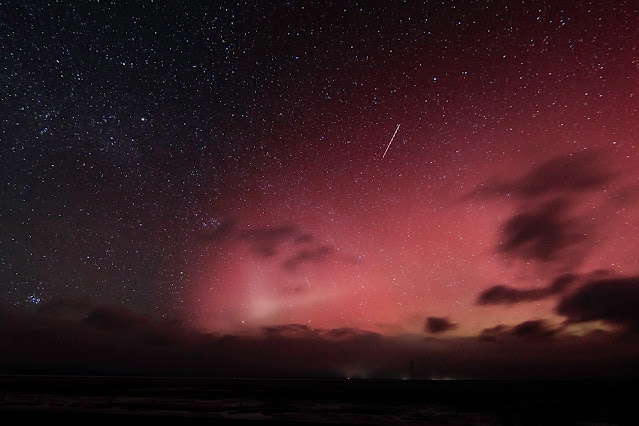For the first time in almost 8 years, I saw a significant display of the Aurora Borealis (Northern Lights). It was a bit of a slog, though. I had looked at Spaceweather.com in the morning and seen the possibility for some auroral activity over the next day, but forgot about it during work and even after work as I ate supper and watched the end of a basketball game. Most of the time, these aurora forecasts either fizzle, or the auroras aren't visible as far south as Southern Oregon, or the storm is over by the time night falls here. Or it's cloudy. The weather during the afternoon was a full-on blizzard at times. During evening twilight, I made a grocery run and noticed it had cleared off. Venus and the Moon were in a pleasing formation, with Jupiter far below. But I didn't remember to check on the aurora. Both of the late tournament games went down to the wire, and it wasn't until after those ended that I thought about checking in on the space weather again. When I did, there was an ongoing severe geomagnetic storm. Unfortunately, clouds were back overhead and particularly to the north. The forecast wasn't encouraging, but the satellite showed some clear patches to the east and maybe farther north. I put on clothing layers, grabbed my camera gear, and started my drive. It was almost 10:00pm, and I wasn't sure how long the display would last.
I opted to head north on Highway 97, rather than east on Highway 140. I had a couple of spots in mind if skies were clearer than expected. As I rounded Upper Klamath Lake, there were some clear areas, but they were to the west. A glow to the north teased me a couple of times, but it was just lights shining off low clouds. My first stop after exiting the light bubble of Klamath Falls yielded totally cloudy conditions. Another check of the satellite seemed to indicate that if I kept driving northward I would run into patchier clouds. At least I had the snow-free highway to follow. I ran into snow showers and a few clear patches overhead, but no clearing along the northern horizon. Finally, I could see the stars of Cassiopeia only partly obscured by clouds. I turned east on the road to Klamath Marsh National Wildlife Refuge. I knew that once I was on the refuge there would be an unobstructed northern horizon and some parking turnouts. It was a tense few miles as the road was icy and I was trying to look to my left to see the northern sky. I was encouraged by seeing a glow behind the clouds, but I needed to keep going until I reached a safe place to park.
I got out and set up my tripod and camera. There was a modest auroral glow over most of the northern sky, interrupted by dark patches of clouds. The horizon area where the aurora should have been brightest was completely clouded over. I didn't immediately see any color or structure to the aurora, but the camera was picking up red. Our eyes don't see color well in low light, and especially not in the red part of the spectrum. I have seen vivid red in auroras before; very near this spot over 20 years ago I saw a crimson patch with vertical golden rays running through it. This display just wasn't bright enough for me to perceive those colors, and the green that is usually the easiest color to pick up was hidden behind clouds. The aurora did eventually gain some structure, with some vertical rays that marched and swayed. There wasn't any crazy dynamic activity, and the most color I could pull out with my eyes was a modest peachy hue.
 |
| My first shot at the aurora. Not until 11:30pm! |
 |
| Foreground lit up by lights from an approaching truck |
 |
| When that truck passed by ... |
 |
| There's actually a lot of classic auroral structure in this image, taken at 11:39pm. It's just all faint. |
 |
| A narrower view of rayed structure |
 |
| 11:47pm |
I kept watching, but the display seemed to subside a bit although the glow remained. Also, the clouds covered more of the sky. I left at around 12:20am, hoping to find a clear patch to the south. I stopped a couple of times but didn't find a good view and the display seemed to be quiet. Finally, back in Klamath Falls, I decided to take a quick jaunt along the west side of Upper Klamath Lake, as there was still clearing to the west. I went through snow showers, but there were some clear patches. When I arrived at Howard Bay, there was a patch that ran down to the northern horizon, so I could see more of the green that was previously obscured. If I had gone against all of my instincts and turned west at the beginning of my trek, maybe I would have gotten reasonably skies here (as well as nice reflections) and not lost an hour of travel. Or maybe not, and now this auroral display is history.
 |
| 1:46am from Howard Bay |










Comments
Post a Comment